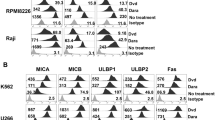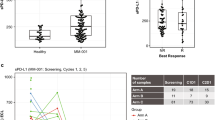Abstract
The aim of this study was to investigate the in vitro immunomodulatory effects of zoledronic acid (Zol) on peripheral blood Vγ9/Vδ2 (γδ) T cells of normal donors and multiple myeloma (MM) patients. γδ T cells were stimulated with Zol and low doses of interleukin-2 (IL-2), and then analyzed for proliferation, cytokine production, and generation of effector activity against myeloma cell lines and primary myeloma cells. Proliferation of γδ T cells was observed in 100% of normal donors and 50% of MM patients. γδ T cells produced IFN-γ, surface mobilized the CD107a and CD107b antigens, and exerted direct cell-to-cell antimyeloma activity irrespective of the ability to proliferate to Zol and IL-2. The memory phenotype was predominant in the MM γδ T cells that proliferated in response to Zol (responders), whereas effector cells were predominant in those that did not (nonresponders). Zol induced antimyeloma activity through the monocyte-dependent activation of γδ T cells and by enhancing the immunosensitivity of myeloma cells to γδ T cells. Mevastatin, a specific inhibitor of hydroxy-methylglutaryl-CoA reductase, completely abrogated this antimyeloma activity.
This is a preview of subscription content, access via your institution
Access options
Subscribe to this journal
Receive 12 print issues and online access
$259.00 per year
only $21.58 per issue
Buy this article
- Purchase on Springer Link
- Instant access to full article PDF
Prices may be subject to local taxes which are calculated during checkout




Similar content being viewed by others
References
Massaia M, Borrione P, Battaglio S, Mariani S, Beggiato E, Napoli P et al. Idiotype vaccination in human myeloma: generation of tumor-specific immune responses after high-dose chemotherapy. Blood 1999; 94: 673–683.
Coscia M, Mariani S, Battaglio S, Di Bello C, Fiore F, Foglietta M et al. Long-term follow-up of idiotype vaccination in human myeloma as a maintenance therapy after high-dose chemotherapy. Leukemia 2004; 18: 139–145.
Reichardt VL, Okada CY, Liso A, Benike CJ, Stockerl-Goldstein KE, Engleman EG et al. Idiotype vaccination using dendritic cells after autologous peripheral blood stem cell transplantation for multiple myeloma: a feasibility study. Blood 1999; 93: 2411–2419.
Wen YJ, Min R, Tricot G, Barlogie B, Yi Q . Tumor lysate-specific cytotoxic T lymphocytes in multiple myeloma: promising effector cells for immunotherapy. Blood 2002; 99: 3280–3285.
Li Y, Bendandi M, Deng Y, Dunbar C, Munshi N, Jagannath S et al. Tumor-specific recognition of human myeloma cells by idiotype-induced CD8(+) T cells. Blood 2000; 96: 2828–2833.
Wen YJ, Barlogie B, Yi Q . Idiotype-specific cytotoxic T lymphocytes in multiple myeloma: evidence for their capacity to lyse autologous primary tumor cells. Blood 2001; 97: 1750–1755.
Massaia M, Borrione P, Attisano C, Barral P, Beggiato E, Montacchini L et al. Dysregulated Fas and bcl-2 expression leading to enhanced apoptosis in T cells of multiple myeloma patients. Blood 1995; 85: 3679–3687.
Bianchi A, Mariani S, Beggiato E, Borrione P, Peola S, Boccadoro M et al. Distribution of T-cell signalling molecules in human myeloma. Br J Haematol 1997; 97: 815–820.
Mariani S, Coscia M, Even J, Peola S, Foglietta M, Boccadoro M et al. Severe and long-lasting disruption of T-cell receptor diversity in human myeloma after high-dose chemotherapy and autologous peripheral blood progenitor cell infusion. Br J Haematol 2001; 113: 1051–1059.
Brown RD, Pope B, Murray A, Esdale W, Sze DM, Gibson J et al. Dendritic cells from patients with myeloma are numerically normal but functionally defective as they fail to up-regulate CD80 (B7-1) expression after huCD40LT stimulation because of inhibition by transforming growth factor-beta1 and interleukin-10. Blood 2001; 98: 2992–2998.
Ratta M, Fagnoni F, Curti A, Vescovini R, Sansoni P, Oliviero B et al. Dendritic cells are functionally defective in multiple myeloma: the role of interleukin-6. Blood 2002; 100: 230–237.
Smyth MJ, Godfrey DI, Trapani JA . A fresh look at tumor immunosurveillance and immunotherapy. Nat Immunol 2001; 2: 293–299.
Kelly JM, Darcy PK, Markby JL, Godfrey DI, Takeda K, Yagita H et al. Induction of tumor-specific T cell memory by NK cell-mediated tumor rejection. Nat Immunol 2002; 3: 83–90.
Parker CM, Groh V, Band H, Porcelli SA, Morita C, Fabbi M et al. Evidence for extrathymic changes in the T cell receptor gamma/delta repertoire. J Exp Med 1990; 171: 1597–1612.
Tanaka Y, Morita CT, Tanaka Y, Nieves E, Brenner MB, Bloom BR . Natural and synthetic non-peptide antigens recognized by human gamma delta T cells. Nature 1995; 375: 155–158.
Bukowski JF, Morita CT, Brenner MB . Human gamma delta T cells recognize alkylamines derived from microbes, edible plants, and tea: implications for innate immunity. Immunity 1999; 11: 57–65.
Davodeau F, Peyrat MA, Hallet MM, Gaschet J, Houde I, Vivien R et al. Close correlation between Daudi and mycobacterial antigen recognition by human gamma delta T cells and expression of V9JPC1 gamma/V2DJC delta-encoded T cell receptors. J Immunol 1993; 151: 1214–1223.
Selin LK, Stewart S, Shen C, Mao HQ, Wilkins JA . Reactivity of gamma delta T cells induced by the tumour cell line RPMI 8226: functional heterogeneity of clonal populations and role of GroEL heat shock proteins. Scand J Immunol 1992; 36: 107–117.
Kunzmann V, Bauer E, Feurle J, Weissinger F, Tony HP, Wilhelm M . Stimulation of gammadelta T cells by aminobisphosphonates and induction of antiplasma cell activity in multiple myeloma. Blood 2000; 96: 384–392.
Das H, Wang L, Kamath A, Bukowski JF . Vgamma2Vdelta2 T-cell receptor-mediated recognition of aminobisphosphonates. Blood 2001; 98: 1616–1618.
Wilhelm M, Kunzmann V, Eckstein S, Reimer P, Weissinger F, Ruediger T et al. Gammadelta T cells for immune therapy of patients with lymphoid malignancies. Blood 2003; 102: 200–206.
Thompson K, Rogers M . Statins prevent bisphosphonate-induced g,d-T-cell proliferation and activation in vitro. J Bone Miner Res 2004; 19: 278–288.
Jedema I, van der Werff NM, Barge RM, Willemze R, Falkenburg JH . New CFSE-based assay to determine susceptibility to lysis by cytotoxic T cells of leukemic precursor cells within a heterogeneous target cell population. Blood 2004; 103: 2677–2682.
Miyagawa F, Tanaka Y, Yamashita S, Minato N . Essential requirement of antigen presentation by monocyte lineage cells for the activation of primary human gamma delta T cells by aminobisphosphonate antigen. J Immunol 2001; 166: 5508–5514.
Dieli F, Poccia F, Lipp M, Sireci G, Caccamo N, Di Sano C et al. Differentiation of effector/memory Vδ2 T cells and migratory routes in lymph nodes or inflammatory sites. J Exp Med 2003; 198: 391–397.
Angelini DF, Borsellino G, Poupot M, Diamantini A, Poupot R, Bernardi G et al. FcRIII discriminates between 2 subsets of Vγ9Vδ2 effector cells with different responses and activation pathways. Blood 2004; 104: 1801–1807.
Alter G, Malenfant JM, Delabre RM, Burgett NC, Yu XG, Lichterfeld M et al. Increased natural killer cell activity in viremic HIV-1 infection. J Immunol 2004; 173: 5305–5311.
Rubio V, Stuge TB, Singh N, Betts MR, Weber JS, Roederer M et al. Ex vivo identification, isolation and analysis of tumor-cytolytic T cells. Nat Med 2003; 9: 1377–1382.
Wang L, Kamath A, Das H, Li L, Bukowski JF . Antibacterial effect of human V gamma 2V delta 2 T cells in vivo. J Clin Invest 2001; 108: 1349–1357.
Takano M, Nishimura H, Kimura Y, Mokuno Y, Washizu J, Itohara S et al. Protective roles of gamma delta T cells and interleukin-15 in Escherichia coli infection in mice. Infect Immun 1998; 66: 3270–3278.
Kabelitz D, Wesch D, Pitters E, Zoller M . Characterization of tumor reactivity of human Vgamma9Vdelta2 gammadelta T cells in vitro and in SCID mice in vivo. J Immunol 2004; 173: 6767–6776.
Kato Y, Tanaka Y, Miyagawa F, Yamashita S, Minato N . Targeting of tumor cells for human gammadelta T cells by nonpeptide antigens. J Immunol 2001; 167: 5092–5098.
Gober HJ, Kistowska M, Angman L, Jeno P, Mori L, De Libero G . Human T cell receptor gammadelta cells recognize endogenous mevalonate metabolites in tumor cells. J Exp Med 2003; 197: 163–168.
Dunford JE, Thompson K, Coxon FP, Luckman SP, Hahn FM, Poulter CD et al. Structure-activity relationships for inhibition of farnesyl diphosphate synthase in vitro and inhibition of bone resorption in vivo by nitrogen-containing bisphosphonates. J Pharmacol Exp Ther 2001; 296: 235–242.
Acknowledgements
We would like to thank Professor John Iliffe for editorial assistance, and Dr Patrizia Falco, Dr Alessandra Bertola, and Dr Federica Cavallo for providing clinical samples. This work was supported by Compagnia San Paolo di Torino (Special Project Oncology), MIUR (COFIN and FIRB, Roma, Italy), AIRC (Milano, Italy), Ministero della Salute (Ricerca Sanitaria Finalizzata), and Novartis Pharma. Fellowship recipients are: S.P. (Comitato Gigi Ghirotti, Torino, Italy), M.M. (Associazione Italiana Amici José Carreras, Torino, Italy), and B.N. (CeRMS-FIRMS, Torino, Italy).
Author information
Authors and Affiliations
Corresponding author
Rights and permissions
About this article
Cite this article
Mariani, S., Muraro, M., Pantaleoni, F. et al. Effector γδ T cells and tumor cells as immune targets of zoledronic acid in multiple myeloma. Leukemia 19, 664–670 (2005). https://doi.org/10.1038/sj.leu.2403693
Received:
Accepted:
Published:
Issue Date:
DOI: https://doi.org/10.1038/sj.leu.2403693
Keywords
This article is cited by
-
Anti-PD-1 antibody armored γδ T cells enhance anti-tumor efficacy in ovarian cancer
Signal Transduction and Targeted Therapy (2023)
-
Zoledronic acid–induced severe lymphopenia
Osteoporosis International (2023)
-
Addition of dexamethasone to manage acute phase responses following initial zoledronic acid infusion
Osteoporosis International (2021)
-
Various pathways of zoledronic acid against osteoclasts and bone cancer metastasis: a brief review
BMC Cancer (2020)
-
Enhancing adoptive cancer immunotherapy with Vγ2Vδ2 T cells through pulse zoledronate stimulation
Journal for ImmunoTherapy of Cancer (2017)



